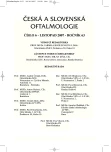Correlation of the Heidelberg Retinal Tomograph, Evaluation of the Retinal Nerve Fiber Layer and Perimetry in the Diagnosis of Glaucoma
Authors:
Š. Skorkovská 1; J. Michálek 2; M. Sedlačík 3; Z. Mašková 1; J. Kočí 1
Authors‘ workplace:
Klinika nemocí očních a optometrie LF MU, Fakultní nemocnice U sv.
Anny, Brno, přednosta doc. MUDr. S. Synek, CSc.
1; Katedra aplikované matematiky a informatiky, Ekonomicko-správní
fakulta MU, Brno, vedoucí doc. ing. O. Vašíček, CSc.
2; Katedra ekonometrie, Univerzita obrany, Brno
vedoucí doc. RNDr. J. Moučka, PhD.
3
Published in:
Čes. a slov. Oftal., 63, 2007, No. 6, p. 403-414
Overview
Purpose:
To assess the correlation of the selected structural and functional methods in the diagnosis of glaucoma.
Methods:
The study group (SG) of 40 patients with primary open angle glaucoma with no or early visual field changes was compared to the control group (CG) of 40 healthy persons of similar age in the first year of prospective longitudinal study. All participants underwent the examination by means of Heidelberg retinal tomograph, photography of retinal nerve fiber layer, standard white-on-white perimetry, and blue-on-yellow perimetry. Only one eye of each examined person was evaluated. Significance was assessed by means of non-parametric test (Mann-Whitney) and the correlation analysis (Spearman) was performed as well.
Results:
No significant differences in age, visual acuity, and refraction between SG and CG were found. The central corneal thickness (p< 0.05) and intraocular pressure (p< 0.01) were significantly different between both groups. The visual field mean sensitivity (MS) and mean defect (MD) of white-on-white perimetry differ significantly between SG and CG comparing to the visual field parameters of blue-on-yellow perimetry. HRT analysis found out significant parameters: cup area (CA), cup/disc ratio (C/D), rim/disc ratio (R/D), and rim volume (RV) (p< 0.05). Cup shape measure (CSM) and Mikelberg discrimination function (FSM) were significant as well (p< 0.01). The loss of retinal nerve fiber layer was significantly different (p< 0.01) between the glaucomatous and healthy eyes. Spearman’s correlation analysis found out significant correlations (MS and MD) only in blue-on-yellow perimetry and CV and RV of HRT analysis by comparison of all healthy and glaucomatous eyes. Another significant correlations were found by comparison of the retinal nerve fiber layer loss to MS (p = 0.00) and MD (p = 0.03) of white–on-white perimetry. Some of HRT parameters: CA, RA, CD, RV, CSM, HVC and RNFL in the group of all 80 eyes were significantly correlated to retinal nerve fiber layer loss. In the group of glaucomatous eyes only, no significant correlations were found.
Conclusion:
Combination of the structural and functional methods can positively improve diagnosis of early glaucoma and better recognize the progression of glaucomatous neuropathy of the optical nerve.
Key words:
glaucoma, perimetry, HRT, retinal nerve fiber layer, correlation
Labels
OphthalmologyArticle was published in
Czech and Slovak Ophthalmology

2007 Issue 6
Most read in this issue
- Opacification of Hydrophilic Acrylic Intraocular Lenses
- Dry Eye Syndrome in Rheumatoid Arthritis Patients
- Correlation of the Heidelberg Retinal Tomograph, Evaluation of the Retinal Nerve Fiber Layer and Perimetry in the Diagnosis of Glaucoma
- Posterior Capsule Opacification (PCO) Following Implantation of Various Types of IOLs – Part One: The Uncomplicated Course
